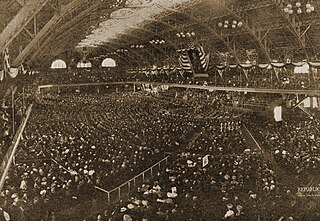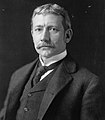| This article needs additional citations for verification. Please help improve this article by adding citations to reliable sources. Unsourced material may be challenged and removed. Find sources: "1908 Republican National Convention" – news · newspapers · books · scholar · JSTOR (January 2017) (Learn how and when to remove this message) |
| 1908 presidential election | |
  Nominees Nominees Taft and Sherman | |
| Convention | |
|---|---|
| Date(s) | June 16–19, 1908 |
| City | Chicago, Illinois |
| Venue | Chicago Coliseum |
| Chair | Henry C. Lodge |
| Candidates | |
| Presidential nominee | William Howard Taft of Ohio |
| Vice-presidential nominee | James S. Sherman of New York |
| Voting | |
| Total delegates | 980 |
| Votes needed for nomination | 491 |
| Results (president) | Taft (OH): 702 (71.63%) Knox (PA): 68 (6.94%) Hughes (NY): 67 (6.84%) Cannon (IL): 58 (5.92%) Fairbanks (IN): 40 (4.08%) La Follette (WI): 25 (2.55%) Foraker (OH): 16 (1.63%) Roosevelt (NY): 3 (0.31%) Abstaining: 1 (0.10%) |
| Ballots | 1 |
| ‹ 1904 · 1912 › | |
The 1908 Republican National Convention was held in Chicago Coliseum, Chicago, Illinois on June 16 to June 19, 1908. It convened to nominate successors to President Theodore Roosevelt and Vice President Charles W. Fairbanks.
U.S. Secretary of War William Howard Taft of Ohio won Roosevelt's endorsement and received the presidential nomination. The convention nominated New York Representative James S. Sherman to be his vice presidential running mate.
The Platform
The Republican platform celebrated the Roosevelt administration's economic policies such as the keeping of the protective tariff, establishment of a permanent currency system (the Federal Reserve), additional government supervision and control over trusts. It championed enforcement of railroad rate laws, giving the Interstate Commerce Commission authority to investigate interstate railroads, and reduction of work hours for railroad workers, as well as general reduction in the work week.
In foreign policy, it supported a buildup of the armed forces, protection of American citizens abroad, extension of foreign commerce, vigorous arbitration and the Hague treaties, a revival of the U.S. Merchant Marine, support of war veterans, self-government for Cuba and the Philippines with citizenship for residents of Puerto Rico.
In other areas, it advocated court reform, creation of a federal Bureau of Mines and Mining, extension of rural mail delivery, environmental conservation, upholding of the rights of African-Americans and the civil service, and greater efficiency in national public health agencies.
The platform lastly expressed pride in U.S. involvement in the building of the Panama Canal, the admission of the New Mexico and Arizona Territories; called for the celebration of the birthday of Abraham Lincoln; and generally deplored the Democratic Party while celebrating the policies of the Republicans. The platform explained the differences between democracy and republicanism in which the Republicans made clear that democracy was leaning towards socialism and republicanism towards individualism.
Speakers

The following individuals spoke at the 1908 Republican National Convention. Many spoke with the goal of nominating a specific nominee as this was before the age of the primary and the nominees were all decided at the convention.
June 16
- Prayer by Rt. Rev. P.J. Muldoon V.G.
- Julius C. Burrows, Michigan Senator
June 17
- Prayer by Rev. William Otis Waters
- Henry Cabot Lodge, Massachusetts Senator
June 18
- Prayer by Rev. Dr. John Wesley Hill
- George Henry Williams, Former Attorney General
- Henry Sherman Boutell of Illinois, Lawyer and diplomat
- Joseph W. Fordney, Congressman of Michigan
- Frank Hanly, Governor of Indiana
- Charles A. Bookwalter, Mayor of Indianapolis
- Stewart L. Woodford, Former Congressman and Judge of New York
- Theodore E. Burton, Congressman of Ohio
- George A. Knight, Attorney and Businessman
- C. B. M'Coy, Ohio Factory Owner
- W. O. Emory, Young Black Delegate from Macon, Georgia
- Robert S. Murphy, Lieutenant Governor of Pennsylvania
- James Scarlet, Prominent Attorney from Danville, Pennsylvania
- Henry F. Cochems, Wisconsin Football Star
- Charles A. A. McGee, Author of "The Truth About Money" from Wisconsin
June 19
- Prayer by Rabbi Tobias Schanfarber
- Timothy L. Woodruff, Businessman and Former Politician
- Joseph Gurney Cannon, Speaker of the House
- Augustus E. Willson, Governor of Kentucky
- Henry Cabot Lodge (again)
- Chase Osborn of Michigan
- James Brownlow Yellowley, Mississippi State Legislator
- Thomas N. McCarter, Former Attorney General of New Jersey and public servant
- William Warner, Senator from Missouri
- Julius C. Burrows of Michigan
Presidential nomination
Presidential candidates
-
 War Secretary
War Secretary
William Howard Taft
of Ohio -
 Senator
Senator
Philander C. Knox
of Pennsylvania -
 Governor
Governor
Charles Evans Hughes
of New York -
 Speaker
Speaker
Joseph G. Cannon
of Illinois -
 Vice President
Vice President
Charles W. Fairbanks
of Indiana -
 Senator
Senator
Robert M. La Follette
of Wisconsin -
 Senator
Senator
Joseph B. Foraker
of Ohio -
 Former
Former
Treasury Secretary
L. M. Shaw
of Iowa
(Not Nominated)
The Republicans faced difficulties selecting a successor to Roosevelt. Elihu Root was favored by Roosevelt, but his age and alignment with corporations made him unpalatable. Prior to the convention, Vice President Charles W. Fairbanks and New York Governor Charles Evans Hughes both seemed like plausible nominees, but Roosevelt was determined to pick his own successor. U.S. Senator Joseph B. Foraker sought the nomination and was financed by Winthrop M. Crane and Henry Cabot Lodge.
Roosevelt supported Secretary of War William Howard Taft. Entering the convention, Taft, buoyed by the support of the popular Roosevelt, was virtually assured of the nomination. U.S. Senator Jacob H. Gallinger was among the supporters of a movement to stop Taft's nomination. Taft won the presidential nomination on the first ballot, overcoming Fairbanks and the other favorite son candidates.
Withdrew Before Convention
Declined to Seek Nomination
| Presidential Balloting | ||
|---|---|---|
| Candidate | 1st | Unanimous |
| Taft | 702 | 980 |
| Knox | 68 | |
| Hughes | 67 | |
| Cannon | 58 | |
| Fairbanks | 40 | |
| La Follette | 25 | |
| Foraker | 16 | |
| Roosevelt | 3 | |
| Not Voting | 1 | |
Presidential Balloting / 3rd Day of Convention (June 18, 1908)
Vice Presidential nomination
Vice Presidential candidates
-
 Representative
Representative
James S. Sherman
of New York -
 Former Governor Franklin Murphy
Former Governor Franklin Murphy
of New Jersey -
 Governor
Governor
Curtis Guild, Jr.
of Massachusetts -
 Governor
Governor
George L. Sheldon
of Nebraska
(Not Nominated)
Taft preferred a progressive running mate such as Indiana Senator Albert Beveridge or Iowa Senator Jonathan Dolliver, but Representative James S. Sherman of New York had the support of Speaker Joseph Gurney Cannon and the New York delegation, as well as western support from Senator Charles Curtis of Kansas. Sherman was a fairly conservative Republican who was nonetheless acceptable to the more progressive wing of the party. Sherman won the vice presidential nomination on the first ballot, taking 816 of the 979 votes cast. Former New Jersey Governor Franklin Murphy received 77 votes while Massachusetts Governor Curtis Guild, Jr. received 75 votes, with the remaining votes going to Governor George L. Sheldon of Nebraska and Vice President Charles Fairbanks.
Declined to Seek Nomination
-
 Senator
Senator
Albert J. Beveridge
of Indiana -
 Governor
Governor
Albert B. Cummins
of Iowa -
 Senator
Senator
Jonathan P. Dolliver
of Iowa -
 Attorney General
Attorney General
Herbert S. Hadley
of Missouri -
 Governor
Governor
Charles E. Hughes
of New York
| Vice Presidential Balloting | ||
|---|---|---|
| Candidate | 1st | Unanimous |
| Sherman | 816 | 980 |
| Murphy | 77 | |
| Guild | 75 | |
| Sheldon | 10 | |
| Fairbanks | 1 | |
| Not Voting | 1 | |
Vice Presidential Balloting / 4th Day of Convention (June 19, 1908)
See also
- History of the United States Republican Party
- List of Republican National Conventions
- United States presidential nominating convention
- 1908 United States presidential election
- 1908 Democratic National Convention
References
- Mowry 1960, p. 29.
- ^ "James S. Sherman, 27th Vice President (1909–1912)". US Senate. Retrieved 8 October 2015.
- "Charles Warren Fairbanks, 26th Vice President (1905–1909)". US Senate. Retrieved 9 October 2015.
- ^ Mowry 1960, p. 30.
- "Convention on, Taft Controls". New York Times. 17 June 1908. Retrieved 8 October 2015.
- "Taft Named; First Ballot". New York Times. 19 June 1908. Retrieved 8 October 2015.
- Curtis, Charles. In His Own Words. Kansas State Historical Archives.
- ^ Tweedy, John (1910). A History of the Republican National Conventions from 1856 to 1908. Republican National Convention. pp. 389–390. Retrieved 8 October 2015.
Works cited
- Mowry, George (1960). Theodore Roosevelt and the Progressive Movement. University of Wisconsin Press.
External links
- Republican Party platform of 1908 at The American Presidency Project
- Taft acceptance speech at The American Presidency Project
| Preceded by 1904 Chicago, Illinois |
Republican National Conventions | Succeeded by 1912 Chicago, Illinois |
| (← 1904) 1908 United States presidential election (→ 1912) | |||||||||||
|---|---|---|---|---|---|---|---|---|---|---|---|
| Republican Party (Convention) |
| ||||||||||
| Democratic Party (Convention) |
| ||||||||||
| |||||||||||
| William Howard Taft | |
|---|---|
| |
| Presidency (timeline) |
|
| Chief Justice, Supreme Court | |
| Other actions | |
| Life and legacy | |
| Elections | |
| Family |
|
| Related |
|




